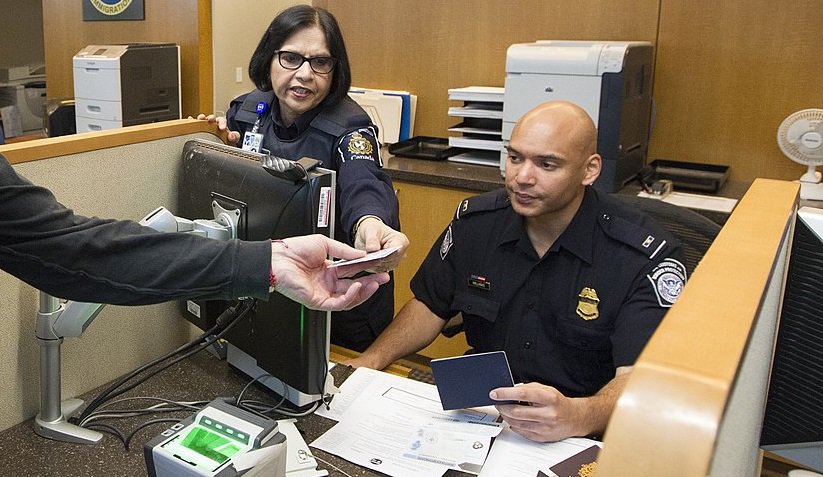
If you are wanting to learn to fly in the U.S. but you are not a U.S. citizen then you are going to need a visa. I was in the same boat as you are right now back in 2004 when I wanted to leave the UK and fly in the States.
Back then the information was not as freely available on the internet as it is now but it’s still not the best. This guide was written to help you understand everything you need to know about the visas needed for learning to fly in the U.S.
International students wishing to learn how to fly in the U.S. need either an M-1 or F-1 visa. The M-1 visa allows training only, while the F-1 visa allows training & then employment as a flight instructor. The M-1 visa is valid for 12 months, the F-1 visa is valid for 18 months.
Getting a visa to be able to train in the U.S. is a pretty straightforward process but there are several things you need to know about each type of visa before you begin looking at the schools you wish to train at.
What is a Visa?
A Visa or Visa Waiver is an application-based process that grants you permission to stay, study, and sometimes work in the United States.
There are many types of visas available to persons entering the U.S. and ensuring you have the correct one will prevent you from possibly being arrested and deported. Many people visit the U.S. on their passport which is a visitor visa, this allows that person to visit and then leave, but not to study, work or earn compensation.
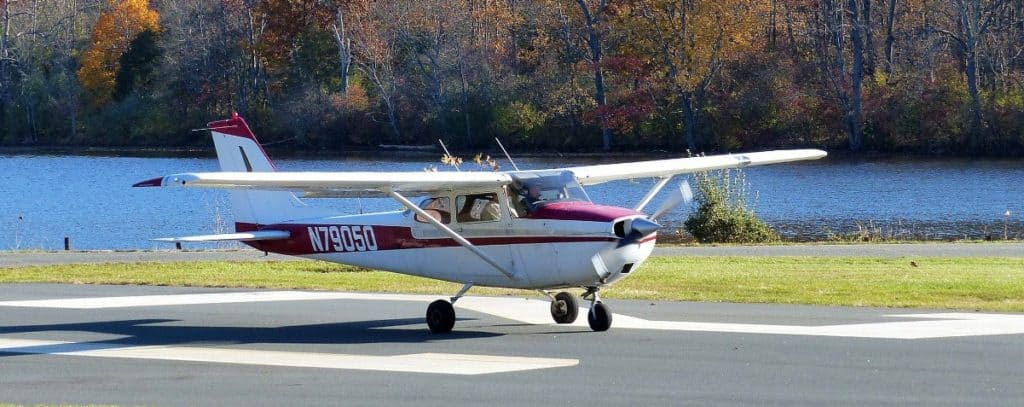
To learn to fly there are two visas that are applicable and each has its own rules for its use. The visas are:
- M-1 Visa
- F-1 Visa
Let’s take a look at each one…
M-1 Visa
This is the most common international student visa available for use at most flight schools across the U.S. It is a visa that allows a student to undertake flight training and it is valid for 12 months. If further training is required the student can apply to the Department of Homeland Security to have the visa extended for a further 12 months.
However, once the flight training is completed or the visa expires the student must leave the U.S. This visa does not allow the student to work while training or when their training is completed.
The M-1 visa is for flight training only!
Once an M-1 visa has been issued it cannot be upgraded to an F-1 visa!
This visa is really good for students who wish to gain specialized flight experience, pilot certificates, or ratings which they will then convert back in their home country.
F-1 Visa
The F-1 visa is aimed at the career pilot who wishes to train and then work as a flight instructor for the duration of their visa. This was the route that I took in 2006, although back then the program was different and my visa was called a J-1 visa.
Because this visa allows students to work after their training, it requires a deeper background security check, financial proof and it is only accessible through a handful of flight schools.
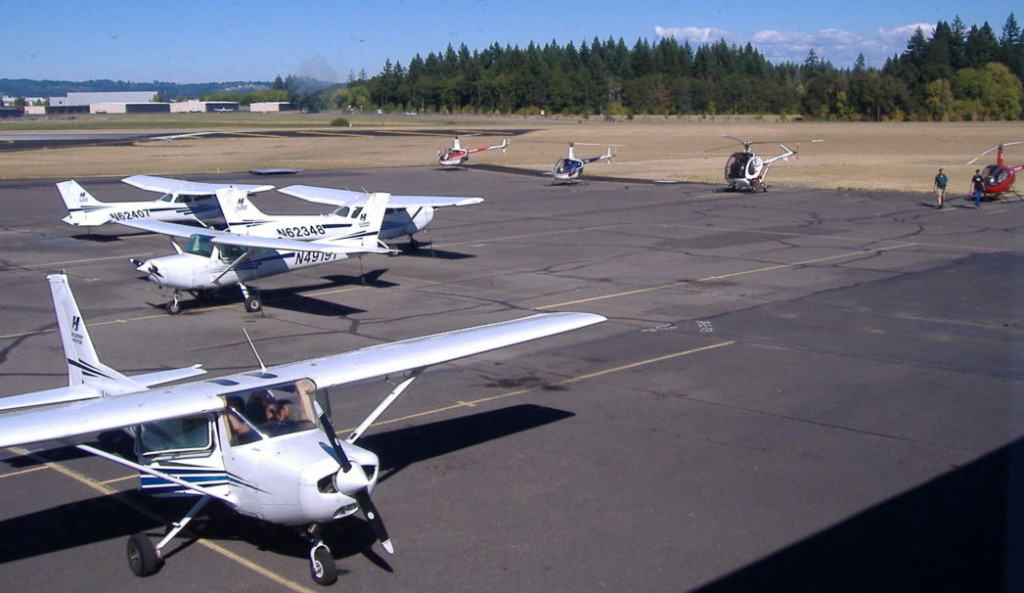
For a flight school to be able to offer the F-1 visa it has to be accredited by the Department of Homeland Security and run FAA-approved Part 141 training programs. The schools also need to be able to provide student services like accommodation, employment, and assistance to all its international students.
An international flight student on an F-1 visa will be the responsibility of the student program manager at the school who will need to liaise with that person for the duration of their stay in the U.S.
Below is a list of the Only FAA Accredited Part 141 Schools Approved for the F-1 Visa:
| SCHOOL | LOCATION | AIRCRAFT | WEBSITE |
|---|---|---|---|
| FlightSafety Academy | Florida | FW | Link |
| Phoenix East Aviation | Florida | FW | Link |
| Aviator College | Florida | FW | Link |
| Aero Cadet | Florida | FW | Link |
| Academy of Aviation | NY, NC, GA | FW | Link |
| Mauna Loa Helicopters | Hawaii | RW | Link |
| Hillsboro Aero Academy | Oregon | FW & RW | Link |
| Embry-Riddle Aeronautical University | FL, AZ | FW & RW | Link |
| Pelican Flight Training | Florida | FW & RW | Link |
The F-1 visa allows a student 18 months from the day of entry into the U.S. to complete any flight training they wish. Most students will aim to become a CFI – Certified Flight Instructor.
Upon gaining their CFI certificate the student should begin to look to gain employment at the school in which they trained (internship) or at any other flight school in the country (externship).
Once a job offer has been accepted the student can then train to get additional instructor ratings like the Multi-Engine Instructor under 3-month extensions known as CPT (Curricular Practical Training). Extensions can only be applied for up to a maximum of 11.5 months total.
Up to 90 days before the completion of the CPT and with a Job offer the student can then apply for an OPT (Optional Practical Traning) extension which will then grant an additional 12 months in which to work as a flight instructor and gain experience.

Join My Newsletter & Get Great Tips, Information and Experiences To Help You Become a Superb Pilot!
Once the visa expires that person will have 60 days to leave the U.S. unless they have gained an additional visa to allow them to legally stay and work. This is usually only granted through winning the ‘Green Card Lottery’ (Electronic Diversity Visa Program), marriage, or starting a business. Those are all topics you will need to investigate further if this is something that interests you.
Trying to stay in the U.S. legally after your visa expires is very difficult to do! I believe the current wait time for Permanent Residency applications is over 8 years!
Learn More…
Try These Articles:
* Flight School Requirements – Are There Any For Joining?
* Flight School Reputation – Does It Matter Where You Train?
* Flight School: Full-Time Vs Part-Time Training
* Do Flight Schools Drug Test Students & Instructors?
How Do You Apply for M-1 or F-1 Visa?
The first step is to decide which visa you require. If you are only flight training with the plan to return back to your home country to work, then the M-1 visa is best suited to you.
You can begin to look at the many flight schools across the country that offer the M-1 visa.
Do not expect a flight school to offer the F-1 visa just because they offer the M-1 visa! They have to be accredited to offer both!
If you wish to pursue a career in aviation and are looking for a complete flight training program then you will need to contact the schools in the list above as they are the only schools approved for the F-1 visa (at the time of writing this).
Once you have the visa type selected then you need to begin a thorough investigation into each flight school you wish to train at. It is an expensive career you are about to undertake and it needs accurate attention and planning.
I highly recommend you take a look at the ‘Further Reading’ section at the end of this article as it has many more articles to help you in your flight school research!
Once you begin to narrow down the flight schools to a shortlist you will need to speak to their staff members that deal with international students. Stay away from schools that do not have considerable experience with training international students. If they mess up you could be deported, with no flight training or money left in your bank account!
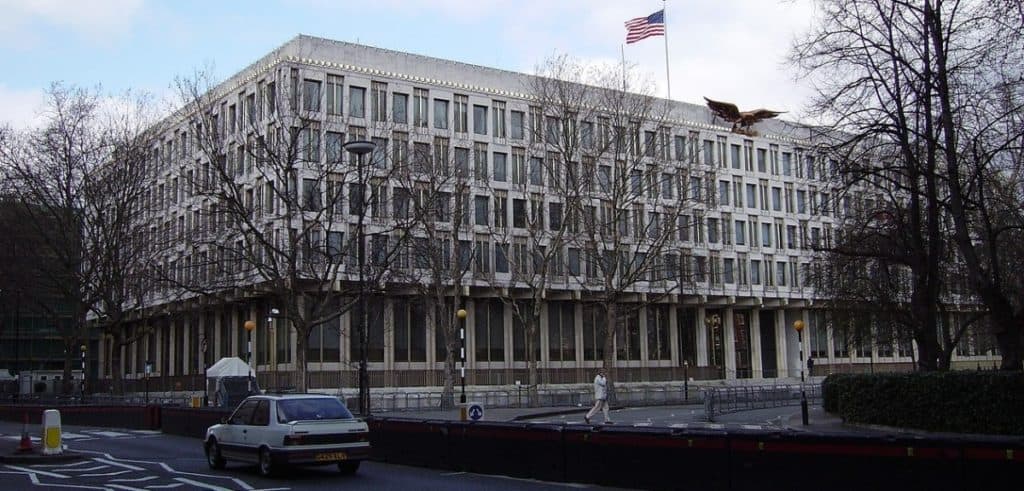
No matter which visa you select, the school will have a checklist of tasks and paperwork that you will need to complete before they can issue you an I-20 form that will begin the application for the visa.
Here is a typical visa application process:
STEP 1: Apply to the school for admission into one of their flight training programs and pay any enrollment fees
STEP 2: Submit your details to the TSA under a Training Request – More details can be found Here at the TSA Alien Flight Student Program website (and Yes, international students are referred to as Aliens! Nice Hey!!)
STEP 3: Receive an I-20 Form. Verify all the information is correct and sign it. Pay the I-901 Student and Exchange Visitor Information System (SEVIS) fee ($350US) – Click Here For SEVIS Fee Details
STEP 4: Make an appointment at your nearest U.S. Embassy for a visa interview. Pay their fee and get all your documents ready to take with you ($160US)– Click Here For Interview Fee Details
STEP 5: Organize your travel details, financials, and home country necessities to get ready for leaving
STEP 6: Arrive in the U.S. – If your school is collecting you from the airport make sure you have this arranged!
STEP 7: Arrive at the school for student orientation and begin your training
This is a very generic list and your chosen school will walk you through their process, forms, and fees to ensure it goes smoothly!
To Help You Even Further Please Feel Free to Download these Free Tools:
- Printable .pdf of the steps listed above to help you track your application process
- Flight School Cost Comparison tool to help you narrow down your flight school selection
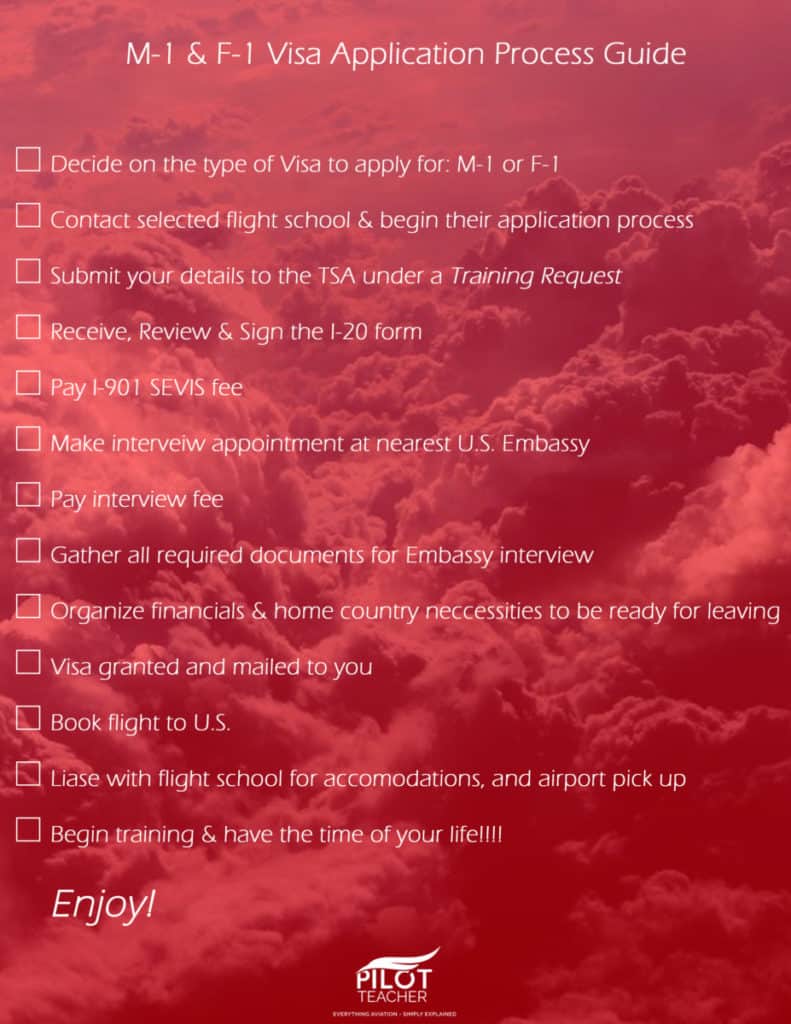
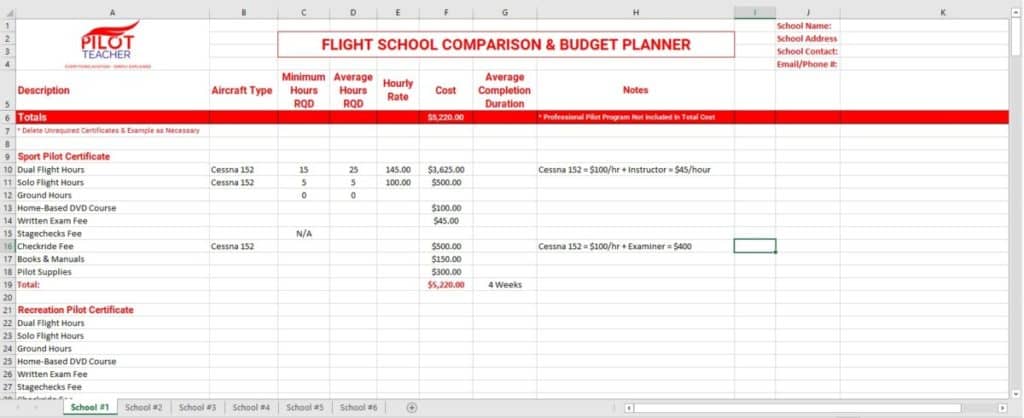
To Finish
If you want to just train, gain specialized experience, and head home, then the M-1 visa is the right one. If you wish to learn and gain extensive flying experience before moving to another country or heading back home to convert your licenses, then the F-1 is the visa choice for you!
My flight training and instructing days were some of the best years of my life and getting the visa and school selected was a simple task providing you stay on top of paperwork and correspondence.
I prepared my own binder that everything went into. Receipts, emails, checklists, so that when I went to the U.S. Embassy or arrived at the border I had everything in one place and it made the application seamless. I highly recommend you do the same!

